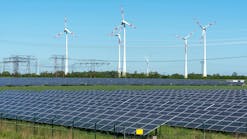Faced with rapid evolution of generation, transmission and distribution technologies, utilities are poised to undergo their most visible transformation in more than a century. By actively pursuing grid modernization efforts now — deploying smart devices, predictive analytics and active network management strategies — they can overcome the pitfalls of aging infrastructure assets and meet rising customer demand for clean energy, reliability and lower carbon footprint.
The recently released 2019 Strategic Directions: Smart Utilities Report by Black & Veatch, Overland Park, Kansas, found after surveying more than 200 utility operators that utility business models are undergoing a change to accommodate the growing volume of renewable energy coming onto the grid. Now, smart grid devices are gathering staggering amounts of data on consumption habits and system health. This is driving adoption of powerful new software that not only collects this information but makes it actionable. This gives utility managers an unprecedented tool to plan for energy needs of the future.
The report explores how transformative initiatives — from greater integration of renewable energy and distributed energy resources (DERs) to proliferation of electric vehicles (EVs) — are reshaping the market and fueling the push for grid modernization. Satisfying future distribution and energy-storage demands will require a highly connected, actively managed electrical grid armed with digital technologies and devices that can support two-way, real-time power requirements. These increasingly complex systems will demand holistic network management strategies that often fall outside the skill sets of a utility. This will open the door for new workforce resources.
The report explores how common DER applications such as rooftop solar, on-site batteries and smart thermostats are rapidly being adopted and are driving utilities and consumers to capitalize on ways to generate, store and monitor power. In a section exploring the challenges associated with accommodating DERs, the report draws a comparison between grid technologies and the streaming outlets revolutionizing the music industry: “Just as music services such as Spotify and YouTube give artistes a platform to share and monetize their products without the oversight of a record company, a DER marketplace can have the same impact on our electric grid.”
“Energy, just like music, can now be generated from (nearly) anywhere and by (nearly) anyone," that section's authors submit. “The question is, do utilities have the mechanisms in place to ensure the DER revolution will play them a favorable melody?”
“Sharp planning and management will be essential as grid modernization spreads and technologies such as smart meters, automation technology and energy storage get added to the power grid,” said John Janchar, the president of Black & Veatch’s telecommunications business. “This is the new normal, with DER and the march of technology changing the game of electricity delivery. Utilities cannot afford to stay on the sidelines.”
The report found that roughly one in five survey respondents says their utility plans to allocate more than $200 million to modernization investments over the next three years while an additional 26% report they will devote $100 million to $200 million.
“That heavy lifting takes more than just innovation and a forward-thinking mindset,” said John Chevrette, the president of Black & Veatch’s management consulting business. “Utilities also must pick experienced partners in network management to give them peace of mind that this energy transition will be seamless, safe and worth the investment.”
Other Key Findings:
- Nearly four of every five respondents say they expect their telecommunications programs to grow over the next five to 10 years and are actively planning for that shift. Another 16% anticipate change but have not begun planning.
- Budget constraints and competing priorities tied as top barriers to modernization, followed by regulatory hurdles.
- Thirty percent of utilities now provide at least five DER customer programs (demand response and/or distributed generation). Less than 16% provide just one.
- Underscoring that distributed energy is by far the top application that utilities plan to support in the immediate future, nearly three-quarters of the survey respondents cited DER in general as shaping their distribution infrastructure in the coming years while 56% named EV charging.
- The report finds that smarter grids, which rely on interconnectedness, will require active network management, holding the promise of better monitoring, control and automation capabilities.
- Nearly 77% of the utilities plan to adopt a managed charging approach to balance increased load on the grid from EV charging.
- Utilities continue to recognize the critical role that cybersecurity plays in ensuring the future health, reliability and resilience of the electric grid.


